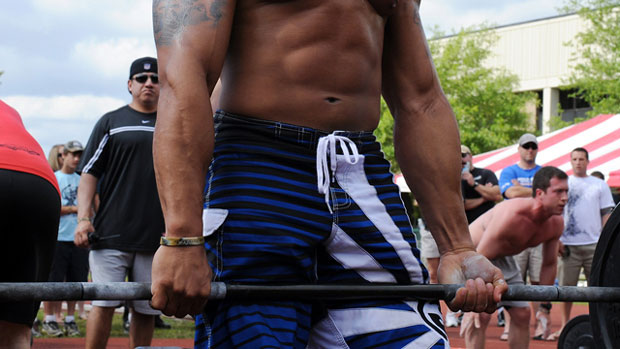Plantar fasciitis is debilitating. When you step out of bed, it feels like stepping on a bed of nails. It improves a bit as you walk around, but later in the day, the pain intensifies across the bottoms of your feet where your arches run and even travels into your heels. You'll probably Google "plantar fasciitis treatment." But what you'll find just temporarily relieves the pain and doesn't fix the problem.
When you start dreading leg days, it gets annoying. When you start skipping lifts altogether, then you know it's gone from annoying to injury.
The first mistake is grinding through the pain until you create other issues at the knees, hips, or low back due to compensatory form changes. This sucks because now you have multiple issues above the foot, in addition to your burning plantar fasciitis.
The second mistake is to follow the advice from many doctors or rehab clinicians suggesting to roll your arches with a lacrosse ball, ice it, and stretch it. If you've followed this advice, then you're probably already laughing or getting pissed. You know that approach will help you to feel better for a few days, but as soon as you try to get back to your heavy lifts or spend a lot of time on your feet, the pain comes back with a vengeance.
The problem with this passive treatment approach? You've done nothing to change tissue quality or the tolerance and capacity of the tissue. Who cares if lacrosse balls, ice, and stretching make it feel good temporarily if you're back to ground zero every time you go for a long walk or try to squat again.
There's a better way to get your plantar fasciitis under control and keep it from coming back. First, let's understand what we're dealing with.
Let's clear up some confusion. It's widely assumed that plantar fasciitis (or fasciopathy) is simply inflammation of the plantar fascia. But more accurately, it's in part a result of chronic breakdown or degeneration of collagen cells within the plantar fascia tissue.
It's not an "itis" or acute inflammatory issue that's causing the problems. It's more related to collagen tissue gone bad over time in the plantar fascia.
- The plantar fascia (or plantar aponeurosis) is made up of multiple bands of fibrous connective tissue running from the heel to the flexor tendons of the toes. Its function is to support the arch of the foot and provide shock absorption.
- When the plantar fascia is on tension during the push-off of the gate cycle, it
triggers the "windlass mechanism," which creates a critically important rigid foot from which to push off and provides stability from the ground up with each step. This helps us to guide more effective treatment. - The Achilles tendon and calf muscles are closely related to the plantar fascia. The Achilles tendon and the plantar fascia merge or blend at the back and bottom of the heel.
- Instead of viewing plantar fasciitis as an acute inflammatory condition, it's important to frame it as a tissue quality problem of the plantar fascia that occurs when you ask it to take more than it can handle. Basically, it's not strong enough, so it slowly breaks down.
First, stop pushing yourself into new injuries up the chain due to compensations. You can't ignore a flared case of plantar fasciitis.
Also, beware of treatment plans that only include passive strategies such as rest, stretching, ice, lacrosse ball rolling, or getting a cortisone shot. This approach will only mask or temporarily relieve the pain, but it won't provide a lasting fix.
Fixing your plantar fasciitis once and for all requires taking a more active approach. You have to strengthen your plantar fascia, Achilles, and calves to finally get back to your big lifts (1, 2).
Here are five key strengthening exercises you need. They'll help you get rid of nagging injuries, including plantar fasciitis, Achilles tendinitis, and calf strains. If you have problems like these, it'll limit your ability to do squats, deadlifts, lunges, step-ups, or any heavy carry variation.
Exercise 1 – Wall Eccentric-Only Heel Raise
- Use the wall to help keep your balance.
- Go up using two feet and lower down on one foot.
- Avoid rolling to either side of your foot.
- Aim for the highest range on your tip-toe position.
- Lower each rep for at least 3 seconds.
- Shoot for 2-4 sets of 8-15 reps.
Exercise 2 – Wall One-Leg Heel Raise with Toe Extension
- Use a towel or other prop under your toes to create a stretch.
- Lean slightly into the wall.
- Use the wall for a slight balance assist.
- Avoid rolling to either side of your foot.
- Go slow. Up 2-3 seconds, hold at top 2-3 seconds, lower down 2-3 seconds.
- Shoot for 2-4 sets of 8-15 reps.
Exercise 3 – Kettlebell Seated Heel Raise
- Use the bent-knee position to target the soleus muscle of the calves.
- Place your heel slightly behind the knee for the best angle.
- Achieve full range of motion by pushing for the highest heel raise you can get.
- Lower slowly instead of letting the weight crash your heel to the ground.
- Avoid rolling to either side of your foot while doing the heel raise.
- Shoot for 2-4 sets of 8-15 reps.
Exercise 4 – Dumbbell Staggered-Stance Heel Raise
- Use a staggered stance with heel-to-toe positioning of your feet.
- Get near hip-width distance side-to-side with your feet.
- Distribute your weight evenly on each foot.
- Avoid rolling to either side of your foot.
- Shoot for 2-4 sets of 8-15 reps.
Exercise 5 – Kettlebell Wall Knees-Bent Heel Raise
- Use a bent-knee position to target the soleus muscle.
- Lean slightly into the wall.
- Move your entire body up and down during this action.
- Shorten the dip belt to keep the weight from hitting the ground.
- Avoid rolling to either side of your foot.
- Shoot for 2-4 sets of 8-15 reps.
If you can tolerate your bigger lifts without compromising or compensating form, use these exercises as warm-ups, on off-days, or in between sets of bigger lifts.
Begin by adding the exercises to your workout in place of any lifts that you've had to stop doing due to pain. Between 2-4 weeks later, shift these exercises to your warm-ups. Keeping these in your warm-up or adding them as an active recovery mini-workout will maintain the progress they help you make.
I recommend incorporating ankle mobility exercises and comprehensive ankle strengthening, as well as glute and hip strengthening exercises to round out your approach to addressing plantar fasciitis.
Working through some discomfort is appropriate, but avoid pushing past a 5 out of 10 discomfort level while doing the exercises.
Note: This is not medical advice.
- Rathleff MS et al. High-load strength training improves outcome in patients with plantar fasciitis: A randomized controlled trial with 12-month follow-up. Scand J Med Sci Sports. 2015 Jun;25(3):e292-300. PubMed.
- Wearing SC et al. The pathomechanics of plantar fasciitis. Sports Med. 2006;36(7):585-611. PubMed.





